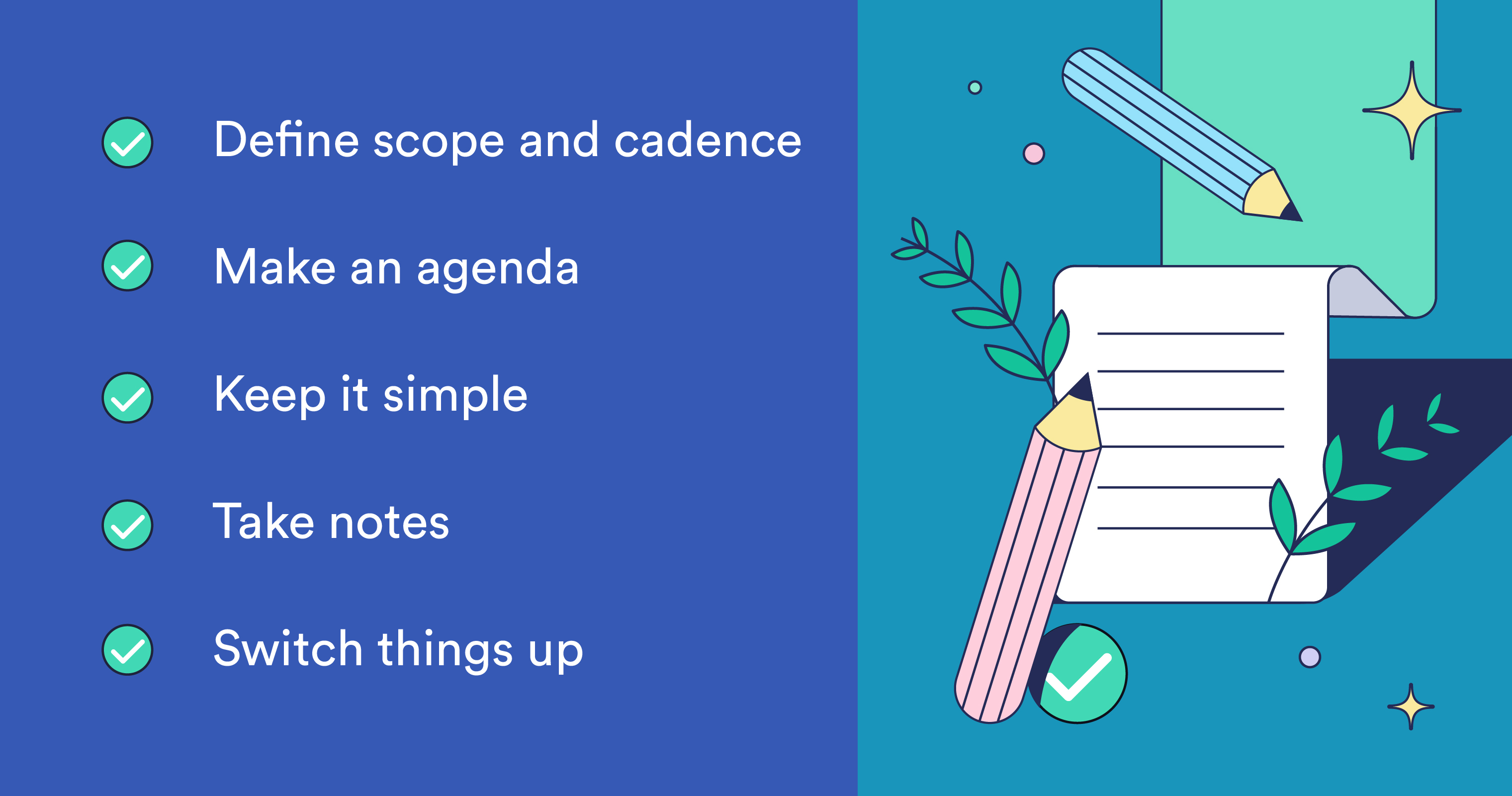
It’s not hard to find basic information about 1:1 meetings—there are many books and articles about practices to keep in mind. But these don’t always give a picture of how powerful these meetings really can be. At many companies, they are used only sporadically. At others, they become sessions for status reports. Such tendencies leave a lot of potential on the meeting table.
I’ve spent many years doing research into how to make 1:1 meetings as useful and effective as possible for all participants. I’m an engineering manager at Grammarly with seventeen years of experience in software development. Currently, I lead a team that provides tooling and platform resources for computational linguists and machine learning researchers. A few years ago, I earned my MBA to strengthen my understanding of the managerial and business side of the technology industry. In this article, I’ll share some of my findings—so that anyone who’s interested can hold 1:1 meetings that are beneficial for managers and team members alike.
Before we go any further, I should make clear exactly what I’m talking about. Some people define a 1:1 meeting as “an employee meeting,” but I don’t agree with this definition. I believe these meetings are equally important for both parties—for the employee and the manager. I see them as a chance for two people to mutually share thoughts and opinions, get feedback, and build a better understanding of each other. Good 1:1 meetings will lead to emotional rewards in the form of praise and appreciation.
Pioneering engineer and businessman Andrew S. Grove said it well in his classic book High Output Management:
It turns out that the one-on-one is not only a fundamental element in the manager/employee relationship, but perhaps the best source for organizational knowledge that a manager can get. In my experience, managers who don’t have one-on-ones understand very little about what’s happening in their organizations.
I like that quote because I think it gives a good sense of just how important 1:1 meetings are to the health of an organization. With all that in mind, let’s get into some specifics.
Benefits and goals of 1:1 meetings
A central goal of 1:1 meetings is to build trust between a manager and a team member in order to strengthen that working relationship. That goal supports everything that follows. All projects, tasks, initiatives, issues—everything—become much easier when that relationship is built on trust.
In support of trust-building, here is a first principle of 1:1 meetings: Everything that is discussed there, stays there. To ensure that both parties can speak freely, each person has to know that what they say in their meeting won’t be disclosed.
If you set up your 1:1 meetings with that expectation of trust and privacy, you can cover a lot of ground. Here are a few categories of what good 1:1 meetings can help facilitate.
Mutual feedback
Feedback is essential. It’s fuel for growth, and everyone needs it.
Managers sometimes underestimate how important it is to save space in 1:1 meetings for feedback—in both directions. It’s not only crucial for an employee to hear feedback from their manager; it’s also vital for a manager to hear regular feedback from an employee. Holding consistent space in 1:1s helps ensure that all team members feel comfortable delivering necessary information.
Feedback is not all the same—there are many types. I like to split things up according to the model proposed by Douglas Stone and Sheila Heen in their book Thanks for the Feedback, which examines feedback in three types: appreciation, coaching, and evaluation. These have different functions, and we all need all three.
- Appreciation motivates and encourages
- Coaching helps you improve
- Evaluation helps you understand where you stand and what’s expected of you
Problem-solving
While it’s important not to turn 1:1 meetings into reporting sessions for project status (more on this below), they can be very useful opportunities to address ongoing issues and dig deeper. Managers and employees can use them to spend time clarifying ambiguous or confusing aspects of work and then collaborate on finding solutions. It can be hard during the rest of the week—when time is prioritized for completing tasks and projects—to devote time to solving bigger, more complex problems. 1:1 meetings provide an excellent opportunity to dedicate the necessary time and focus.
Understanding and reinforcing motivation
I believe that motivation is ultimately intrinsic and that we can’t alter it. But if we’re curious and interested, we can learn what motivates other people in order to discover what factors need to be present to activate that intrinsic mechanism.
One aspect of this is engagement. According to the State of the Global Workplace report, released by Gallup in 2017, 85% of employees around the world feel disengaged at work. This is, in the words of the report itself, “particularly alarming”—it indicates that only 15% of employees feel actively motivated by their role. Another report, released by Hays, supports this alarming trend with the finding that 81% of employees are ready to leave their job for the right offer.
Addressing this is crucial, and 1:1 meetings are an ideal place to do so. One great tool for assessing engagement is Gallup’s Q12 questionnaire, which you can find on page 41 on the State of the Global Workplace report I linked to above. You can use these questions in 1:1s to make sure that people on your team are in a position to put their talents to work. You can find more very good advice on keeping people engaged in First, Break All The Rules, a book by Marcus Buckingham and Curt Coffman, which is based on comprehensive manager and employee surveys conducted by Gallup.
Coaching and professional development
A good 1:1 meeting practice includes making sure employees are getting what they need to develop and grow in their roles. There are a lot of ways to tackle this. Here are a few I’ve used at Grammarly.
Career planning and follow-through
At Grammarly, we do quarterly career-planning sessions, and I find it to be good practice to pick a couple of items from these sessions that pertain to a team member’s professional growth and then add them to 1:1 agendas. That helps to ensure you follow up on them regularly and monitor career growth throughout the quarter instead of just during the one dedicated meeting.
Exploring talent and potential
I like to talk with team members about how time is distributed among various tasks and consider how it might be distributed in an ideal situation. We discuss what such an ideal situation would look like—and what it would take to get there. Closely related to these discussions are how we think about promotions. We conduct an analysis of the requirements for an employee to reach the next career level, track their achievements to date, and plan next steps to get there.
Optimal challenge
An optimal challenge is when someone has challenging work along with enough support to be successful. If a team member’s work is not challenging enough—if their talents are not being put to work—then their professional growth can stall. They may become disengaged. But if they lack support to achieve their objectives, then they also may start to check out. There’s a healthy balance to pair the two together. I recommend Kim Scott’s excellent overview of this idea in Radical Candor.
Success documents
These are just what they sound like: documents where we write down all of a team members’ successes and achievements. This technique might involve conducting a ten-minute writing session during a 1:1 meeting. The results of this exercise are often surprising—more often than not, an employee and a manager are both amazed by how much has been accomplished. It also provides a manager with an opportunity to express gratitude.
Tips for planning successful 1:1 meetings
What I’ve shared above gives you a sense of the benefits and techniques of 1:1 meetings. Hopefully, they’ve helped outline why these can be so useful for good manager-employee relationships. Here are a few tips to help guide good meetings in practice.

Define scope and cadence
Don’t let your 1:1 meetings be spontaneous—their power comes from consistency and structure. Define the length of your 1:1 meetings and figure out the right frequency. When you’re starting out, you might test various cadences and lengths to find the right combination for you and your team. Once you’ve got them set, stick to the schedule. My team currently does 1:1 meetings on a biweekly schedule, and each has a typical duration of 30 minutes.
Make an agenda
Good 1:1 meetings have a clear agenda—but that doesn’t mean it has to come from the manager. Give team members opportunities to lead the agenda and add questions or discussion points in advance. Every team member has a unique work style and can adjust their 1:1 agenda to match. When the structure is set, a manager can add their questions as well.
Agree on an appropriate time for finishing the agenda beforehand (e.g., a day in advance), so that both employee and manager can check the list of questions and prepare accordingly. Define the channel that’s best for sharing questions, whether that’s a task manager, email, Google Doc, or elsewhere.
I used to plan 1:1 meetings on paper and in Google Docs. More recently, I’ve switched to using Lattice, which I like for its integration with Slack. Both meeting participants get a notification beforehand with the link to the planning template, and both can manage the agenda. I find it extremely helpful and convenient. In addition, the tool tracks meeting history and allows for making private notes.
Keep it simple
As you can tell from the advice above, I believe in preparing thoroughly for 1:1 meetings. But it’s also important not to overdo it and let the preparation take more time than the 1:1 itself. Keeping your agenda clear and simple will help avoid excessive work. This will also keep from overcomplicating the meetings, which will help them remain effective.
Take notes
During your meeting, you should take notes and mark action items wherever works best for you (e.g., in Asana or a Google Doc) so you don’t forget what was discussed and what decisions were made. You can follow up on these items in the next meeting.
Switch things up
Consider changing the environment for your 1:1s from time to time—go for a walk or for a coffee. The flow of your conversation will change in a new environment. The topics you discuss may shift as well.
That’s what I found last year when I started holding 1:1 meetings outside once a month. We doubled the time to one hour, went for a walk, and drank some coffee. Going outside is conducive for deep discussions—we definitely used the extra time, and the variation was wonderful. I found it useful to do this every once in a while, while still mostly holding regularly structured meetings with focused agendas. That way we can get the best of both worlds.
Structuring a 1:1 meeting
There are probably as many different ways to structure 1:1 meetings as there are meetings. You should find what works best for you. Here are some things I have on my mind when I’m planning meetings for my own team. One great resource to look at when thinking about what to include in your own 1:1s is this article by Chloe Hamman, director of people science at Culture Amp.
Consider an icebreaker
It’s always a good idea to start a 1:1 with something positive. I like to think of this as the meeting’s icebreaker—it helps build rapport from the get-go. This could be as simple as asking after your team member’s well-being or simply asking, “What’s on your mind?” You could also start the conversation by bringing up something your colleague is passionate about or proud of. I like to establish common context as much as possible, so I try to think of something we discussed in the previous meeting and start the new meeting there.
Keep an adaptable frame
My team’s meetings all use the same basic frame, though each team member adds items to the agenda as they like.
Here’s the frame we start with:
- Accountability: The team member and manager both list out actions from the previous 1:1 and write out “yes” or “no” depending on whether they are completed.
- Future actions: The team member and manager both list out the actions to be completed by the next 1:1. Feel free to add items here as they appear in the conversation. It is also a good idea to review them before wrapping up the meeting.
- The good: The team member lists out good things that have occurred since the last 1:1. These could be about the company, our department, or the individual. This helps call attention to positive developments and encourages a moment for appreciation. In my family, we follow a similar practice with our kids before they go to sleep to anchor all the good things that happened throughout the day. I find it to be a very powerful technique.
- Improvements: The team member lists out that could be improved. Like the exercise for good things, these could be on the company, departmental, or individual level.
- Feedback from manager to team member: I think of this in a “like/wish that” structure.
- I begin with positive feedback in the form of “I like and appreciate…”
- If I have constructive feedback, I describe the situations that need improvement with concrete examples and details. Then I ask how my colleague sees the situation and whether they think it needs improvement. I explain my point of view, why I think it is important to change this, and what value it will bring. Finally, I ask whether my colleague needs any support to deal with this. Ultimately, this is an expanded form of saying, “I wish that…”.
- Feedback from team member to manager: This follows the same structure.
- Tactical items: We keep a list of work-related topics that we have discussed during this 1:1 to track context and progress.
Check in when circumstances change
When Grammarly moved to fully remote work as a result of the COVID-19 pandemic, I made sure to discuss team members’ comfort—what could I do to make sure they felt supported? I also checked with the team to see whether our usual 1:1 cadence would still work in the new circumstances, or whether they wanted more frequent meetings. It turned out that our usual biweekly cadence still felt right. Even though our working circumstances have changed dramatically, our 1:1 meetings have actually not changed much.
Final notes: Some 1:1 pitfalls to avoid
Everything I’ve shared here is in the services of helping you shape 1:1 meetings that build positive, trusting, effective relationships between a manager and team members. But before I leave you, I want to be sure to offer a few notes of caution about things that could derail your efforts.
Don’t turn 1:1s into status meetings
As I’ve mentioned above, it’s important to ensure your 1:1 time doesn’t become a venue for team members just to report the work they’ve been doing. The meeting should be mutually beneficial—and team members should feel that they have influence over the meeting’s contents.
The best way to avoid this is to keep a list of topics that are best suited for 1:1 meetings. While tactical questions can be discussed, there are other issues that are more necessary to address. Just having this list at hand can help keep you on track.
Rather than use individual 1:1s for status updates, consider whether you’re setting your team up for success with an appropriate meeting structure. My team has consistent status meetings, and if there is not enough time there, we set up ad-hoc meetings. I recommend chapter 4 of High Output Management to learn more about types of meetings, their purpose, and recommended cadence.
Don’t cancel or reschedule
Canceling or rescheduling 1:1 meetings often negatively impacts attitudes toward these meetings. It has the effect of diminishing their importance—and can ultimately damage your productivity. If I need to move a meeting, I first ask permission, then propose a new time and ask whether it works. Skipping a 1:1 should be very rare.
Don’t get distracted
My last piece of advice brings us back to the first—and most important—1:1 benefit and goal: building trust in the relationship between a manager and a team member. To create a space for trust and have effective 1:1 meetings, you need to be present. Don’t check your phone or Slack notifications; don’t refresh your email or send messages. The meeting is effective if you respect its importance. The best way to do this is to focus on the person you’re meeting with and listen actively to what they say.
Further reading
Andrew S. Grove, High Output Management
Douglas Stone and Sheila Heen, Thanks for the Feedback: The Science and Art of Receiving Feedback Well
Marcus Buckingham and Curt Coffman, First Break All The Rules: What the World’s Greatest Managers Do Differently
Kim Scott, Radical Candor: Be a Kick-Ass Boss Without Losing Your Humanity
Julia B. Austin, “Master the One-on-One Meeting” (Harvard Business School blog)
Frank Sesno, Ask More: The Power of Questions to Open Doors, Uncover Solutions, and Spark Change
Chloe Hamman, “24 Great 1:1 Questions” (Culture Amp blog)
Elizabeth Grace Saunders, “Cancelling One-on-One Meetings Destroys Your Productivity” (Harvard Business Review)







